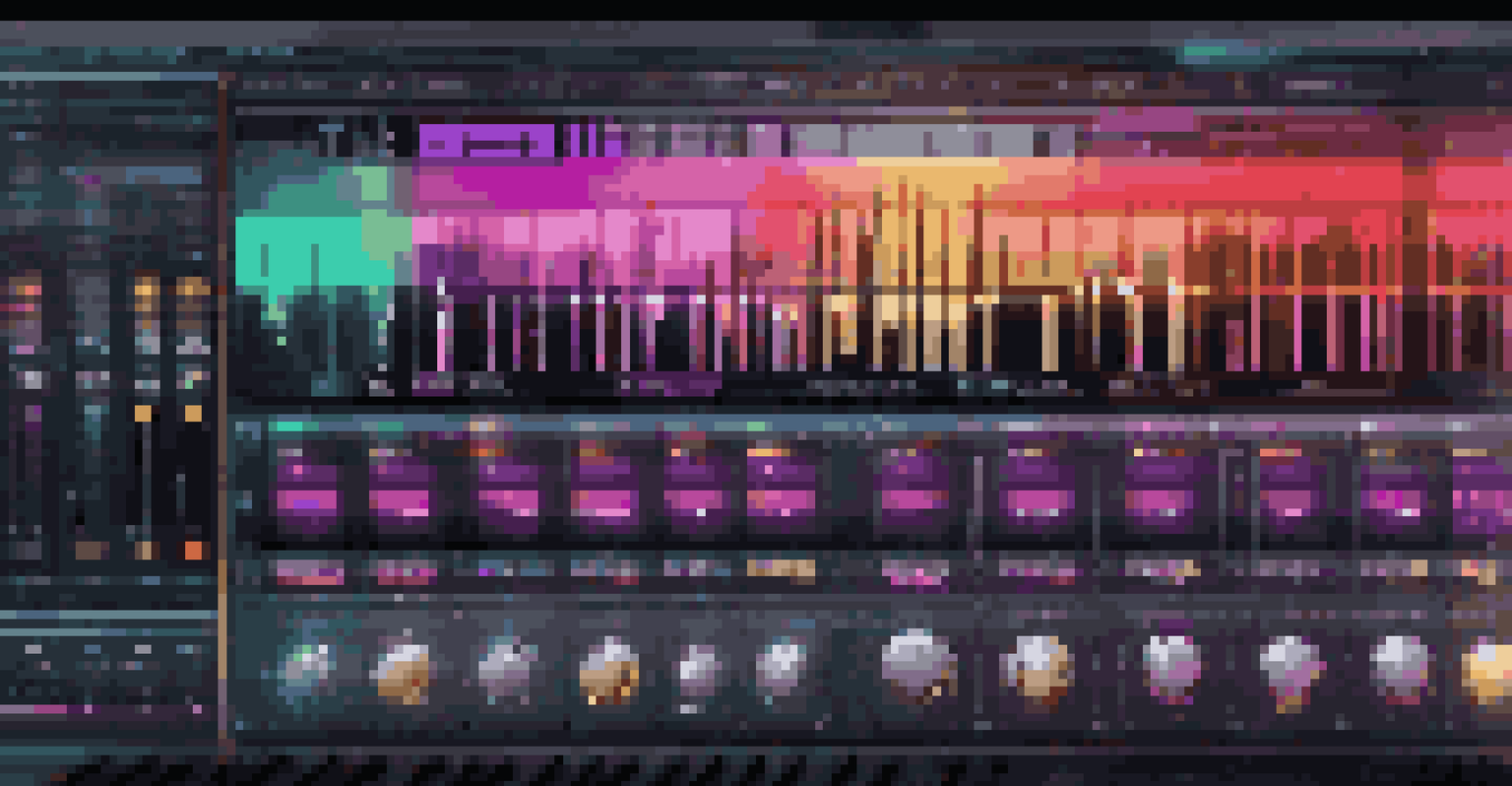The Basics of Music Production: From Concept to Final Mix

Understanding the Music Production Process
Music production is a multifaceted process that transforms ideas into finished tracks. It involves several stages, from initial concept creation to the final mix. Each phase requires different skills and tools, making it essential to understand the entire workflow.
Music is the shorthand of emotion.
At its core, music production is about capturing the essence of a song and translating it into a format that can be shared. This process can seem overwhelming, but breaking it down into manageable steps makes it more approachable. Think of it like baking a cake; you need to gather ingredients, mix them well, and then bake to perfection.
By grasping the basics of music production, you can better appreciate the artistry behind your favorite songs. This understanding will also empower you, whether you're a budding musician or an aspiring producer, to create your own music with confidence.
Crafting Your Initial Idea: The Concept Stage
Every great song begins with a spark of inspiration, often referred to as the concept stage. This is where you brainstorm ideas, themes, and melodies that resonate with you. It's akin to sketching a rough outline before diving into the details of a painting.

During this stage, consider what emotions you want to convey and how you want your listeners to feel. Jot down lyrics, create a melody, or even hum a tune that captures your vision. Don't be afraid to experiment; sometimes, the best ideas emerge from playful exploration.
Music Production is a Process
Understanding the stages of music production helps transform creative ideas into polished tracks.
Once you've solidified your concept, you're ready to move on to the next phase—arranging your ideas into a structured format. This foundational work sets the stage for the entire production process, ensuring that what you create aligns with your initial vision.
Arranging Your Ideas: Building the Structure
After you've got a solid concept, the next step is arranging your ideas into a coherent structure. Think of arrangement as the architecture of your song, where you decide how different sections fit together—like verses, choruses, and bridges. Good arrangement keeps the listener engaged and creates a dynamic flow.
The only way to do great work is to love what you do.
In this phase, you might experiment with different song formats to see what best suits your concept. For example, you could start with a catchy chorus to hook listeners or build tension with a slow verse. The key is to find a balance that highlights the strengths of your ideas.
Once you've outlined your arrangement, you'll have a blueprint to guide your production process. This structured approach allows you to focus on refining each section, ensuring that your final piece resonates with your audience.
Selecting the Right Tools: Software and Gear
Choosing the right tools for music production can greatly influence the outcome of your project. Digital Audio Workstations (DAWs) like Ableton Live, Logic Pro, or FL Studio serve as the backbone for most productions, allowing you to record, edit, and mix your music. Think of a DAW as your creative playground, where all the magic happens.
In addition to software, you'll also need some essential gear, like microphones for recording vocals and instruments, audio interfaces for connecting everything, and studio monitors for accurate sound. Investing in quality equipment can make a significant difference, but remember that creativity is the most crucial tool you have.
Concept Stage Sparks Creativity
The initial concept stage is crucial for brainstorming ideas and emotions that resonate with listeners.
As you familiarize yourself with your chosen tools, don't hesitate to explore tutorials and online resources. The more you learn about the software and gear at your disposal, the more effectively you can bring your musical ideas to life.
Recording Your Tracks: Capturing the Sounds
Once you have your arrangement and tools ready, it's time to start recording your tracks. This stage is where you bring your ideas to life, capturing vocals, instruments, and any other sounds that add depth to your music. Think of this as laying down the foundation of a house; without solid recordings, the rest of your production might crumble.
During recording, pay attention to the details. Ensure that each performance is clean and expressive, as this will enhance the emotional impact of your song. Don't hesitate to do multiple takes to capture the best version of each part; it’s often the subtle nuances that make a performance shine.
After recording, you can begin to layer your tracks, adding harmonies and additional instruments. This layering process enriches the overall sound, creating a fuller and more immersive listening experience. Remember, this is your chance to experiment and let your creativity flow!
Editing Your Recordings: Polishing the Sound
Editing is a crucial step in music production that involves refining your recordings to achieve the best possible sound. This process can include cutting out mistakes, adjusting timing, and enhancing performances. Editing is like sculpting a raw piece of marble into a beautiful statue; it takes time and patience to reveal the final product.
During this phase, you can also add effects like reverb, compression, or EQ to enhance your sound. Each effect serves a specific purpose, such as adding depth or clarity. Understanding how to use these tools effectively can elevate your music from good to great.
Mixing Creates Cohesive Sound
Mixing is essential for balancing individual tracks, ensuring they work together harmoniously for a professional finish.
Once you've completed the editing process, it's important to listen critically to your work. Take breaks to return with fresh ears, ensuring that you're making objective decisions about what works and what doesn’t. This attention to detail will pay off in the final mix.
Mixing Your Track: Balancing and Finalizing Sounds
Mixing is where the magic truly happens, as you blend all your individual tracks into a cohesive piece. This stage involves adjusting levels, panning, and applying effects to ensure that every element of your song is balanced. Think of mixing as orchestrating a symphony; each instrument must work together harmoniously to create a beautiful outcome.
During the mixing process, pay close attention to how each track interacts with the others. You want to ensure that no single element overwhelms the rest; instead, aim for a balanced sound that allows each part to shine. This attention to detail is what separates amateur mixes from professional ones.

Once you're satisfied with your mix, you'll want to take a step back and listen to it on different audio systems. This will help you identify any issues that may not be apparent on your main setup. A great mix should translate well across various listening environments, ensuring your music reaches its full potential.